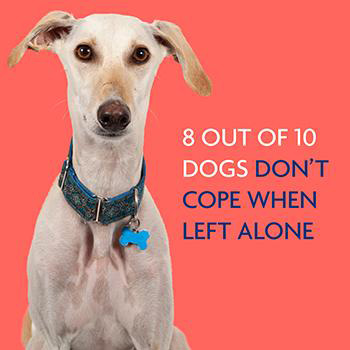Recognising separation-related behaviour and anxiety in dogs
Separation-related behaviour (SRB) occurs when a dog is left alone. In many cases, the behaviour is a result of distress.
Research suggests that 8 out of 10 dogs find it hard to cope when left alone. Yet, half won't show any obvious signs and so it can be easy for owners to miss. The good news is that separation anxiety (SRB) is preventable and treatable.

Identifying separation anxiety
You may know the obvious signs of SRB in dogs, such as destroying furniture or barking. Yet, did you know that there are other signs that may go unnoticed?
The most common signs of separation-related behaviours in dogs are:
- Destructive behaviour, including chewing and destroying furniture, (often near exits, doors or windows)
- Howling, barking, whining
- Toileting (weeing or pooing)
- Excessive excitement upon your return
-
Signs of anxiety before you leave
Other less common (and easy to miss) signs include:
- Trembling, panting
- Excessive salivation
- Self-injury (for example signs of excessive paw licking or tail biting)
- Repetitive behaviour (circling, pacing, barking)
- Vomiting
-
Not eating (meals, treats or engaging with food toys) when you're out
How separation anxiety differs from other health issues
One of the main differences between SRB and other disorders is that it's caused by being left alone. Behaviour shows before or after the owner leaves, starting within a few to 30 minutes.
Underlying health issues can cause or contribute to the development or worsening of SRB. If you're concerned, visit your vet.
Even if you think your dog is happy, every once in a while check for 'hidden' signs of distress. You can do this by installing a camera to monitor your pet while you're out.
Why your dog finds it difficult to cope when left alone
There are several reasons that dogs find it difficult to cope when left alone. Some dogs will look to entertain themselves while their owner is out. Others will simply be distressed when on their own. Read more about training your dog to be left alone.
Treating separation anxiety
Working out why your dog reacts badly to being left alone can be tricky. Especially, as research shows that half of dogs suffering from separation-related behaviour (SRB) won't show any signs when you're with them.
How to treat or prevent separated-related behaviour
Taking positive action to prevent or treat separation anxiety can help if:
- Your dog is showing obvious signs of distress.
- If you don't know whether there's a problem but want to help your dog to feel better when left alone.
- You want to identify if behaviour problems are being caused by other factors. For example, whether destructive behaviour is being caused by a lack of mental stimulation, or if barking is actually caused by a disturbing noise.
Leave a 'special' toy
Always make sure that your dog has exciting things to do when you're not with them. You can give your dog a long-lasting chew such as a stuffed Kong toy, a meat-flavoured chew or a treat ball when you plan to go out.
Make sure that they enjoy using it when you're there. If your dog then doesn't use it when you're away, this may be a sign that your dog is worried when you're out.
Top tip: Remember to take any food treats out of your pet's daily food allowance to avoid overfeeding.
Encourage your pet to relax during their alone time
Try to take your dog for a walk before you go out so that they have the opportunity to go to the toilet and exercise. Return half an hour before you plan to leave and make sure they're not hungry. You can feed them a small meal before you leave or leave a food toy – your dog will be much more inclined to relax if they're fed!
Minimise disturbances
Some dogs will bark at the sight or sound of other people or dogs passing by their window or in response to noises outside. You can prevent disturbances and barking by:
- Closing the curtains to reduce what your dog can see.
- Leaving them in a quiet room.
- Leaving the radio on to muffle outside sounds.
Get a dog sitter
We recommend that you don't leave your dog alone for more than four hours; for puppies much less. However, if your dog struggles with being alone they may start feeling anxious within minutes of you leaving, or even before you leave.
Using a dog sitter or dog walking service means that someone can keep your dog company and take them for a walk. This is a good way of easing the stress they may feel when you're not there.
Never punish your dog
If your dog does something undesirable whilst you're out, it's important you don't show any signs of disapproval. Raising your voice or showing your disappointment might scare your dog and make the situation worse.
Your dog will become anxious about what you'll do when you return the next time you go out, making the behaviour (like chewing and barking) worse.
Dogs who've been told off may lower their head, put their ears back and put their tail between their legs. Sadly, owners often think that their dog looks guilty when they do this and so tell them off thinking they know they've done wrong.
However, even if you take your dog to the 'scene of the crime' they won't associate your anger with their earlier behaviour. Your dog will simply become more anxious the next time you go out. If you do come home to a mess, it's essential not to physically punish or shout at your dog.
Top tip: Try to avoid even letting your dog see that you're annoyed – let them outside before cleaning up.
Leaving your dog to 'cry it out'
Some dog training guides may suggest letting a dog 'cry it out'. This technique, whilst practised widely, is neurologically damaging. Here's why:
- Dogs and puppies left to cry it out will only learn that being alone is terrifying.
- Every time your dog becomes highly distressed, stress hormones occur in the body which can take days to reduce. This can cause negative, long-term effects on your dog's body and mental state.
- Some will sadly learn that calling for their owner to come back doesn't work, so they learn to suffer in silence.
Seeking the help of a professional
If our advice hasn't eased the separation-related behaviour, talk to a vet who knows you and your dog. They should then refer you to a clinical animal behaviourist. They'll help you identify the underlying cause of the problem and develop a personalised treatment plan, which



